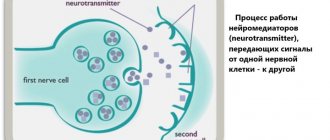No matter how scary it may sound, most people experience thoughts of suicide at least once in their lives.
Most often, a statement about committing suicide is dictated by the desire to attract attention to oneself, but sometimes both the person himself and his loved ones behave incorrectly, which leads to a transition from words to deeds.
What to do if the thought of committing suicide creeps into your head more and more often and it seems that it will be better for everyone?
Causes and consequences of desire for suicide
If you don’t give in to the impulse of the moment and think soberly, you will soon realize that the very idea of self-harmful death is actually absurd. Why? After all, in fact, no matter how bad you feel, suicide will only make everything worse. From a psychological point of view, it will bring with it a huge amount of pain for you and your loved ones, as well as random witnesses to suicide...
The worst thing is that if you do not stop the flow of suicidal thoughts and succumb, you will lose the most important thing - the hope of salvation, of meeting the Eternal Creator after death and eternity in paradise.
Yes, maybe you never believed in God or you invented Him for yourself, giving Him characteristics that were convenient for you. But what will happen if He really exists and if He is the way the Bible shows Him to us? It describes how the Creator, for the sake of saving His creation, descended to Earth and suffered for our sins, so that we would be happy, so that all our sins would be forgiven. However, by committing suicide, you lose the chance of salvation - unfortunately, you will no longer be able to ask for forgiveness for this sin!
Talk about the situation
There is an opinion that the mention of suicide can make a person think about it, but this is a myth. The benefits and risks of asking research participants about suicide: A meta‑analysis of the impact of exposure to suicide‑related content.. If you talk openly with a friend , it will be easier for him to see other options for solving the problem.
Find a comfortable environment
The conversation will likely be very difficult, especially for your friend. Please note that he may feel guilty and ashamed about his intention. Start a conversation where there will be no distractions. Ideally, in a calm, familiar environment.
Touch on the topic of suicide
Start with these questions:
- How do you cope with everything that has befallen you?
- Do you ever feel like you just want to give up?
- Do you often think about death?
- Are you thinking about hurting yourself?
- Have you tried this before?
Speak openly and clearly
Avoid general phrases that may seem accusing (“You keep saying that life has become impossible”). Be more specific, for example: “Over the past few months, I've noticed that you no longer feel happy about the things that used to make you feel good. You stopped spending time with your children." Show that you started this conversation to show you care.
Perhaps at first the interlocutor will act bewildered or laugh at your words. However, if you notice serious red flags, don't let him move the conversation to another topic.
Don't judge
It may seem to you that your friend is wrong in his assessment of events, that everything is not so scary for him. Remind yourself that you cannot fully understand what is going on inside him.
Forget about the widespread opinion in society that suicide is a way out of selfish, crazy or immoral people. Suicidal ideation is the result of a medical condition that is treatable and for which your friend is not to blame.
Don't use phrases that can hurt
Your point of view will not necessarily help a person look at his problems differently. It may seem like you just don't take them seriously. Therefore, do not say phrases like “It’s not that bad.”
Also avoid statements that make you feel guilty, such as, “You have so many reasons to live,” or “Think about how your death will upset your family and friends.” Instead, be compassionate and say, “It must be really hard for you to be having these thoughts.”
Listen and show empathy
This conversation should make your friend feel loved and supported. Try to put yourself in his place and listen without criticism. Look the other person in the eye and show your openness through your body language.
Words of support and encouragement are important, but let the other person talk first. Don't interrupt him. After he has spoken, express your point of view. Mention that suicide is a permanent solution to a temporary problem. Assure that you and other loved ones will help you find alternative solutions to the situation.
Let your friend know that you love him and that he is an important part of your life. Emotional support at such a time is a very important incentive to live on.
Startup project to overcome fear and pain through thoughts
For many people, death is scary only because they have to endure physical pain. And it's true - no method of suicide is actually painless! You should not trust those who on forums give advice on how to die without pain - all suicides, without exception, are found with terrible grimaces of suffering, in vomit and feces, blood and urine (it all depends on the method of suicide). In the end, just ask these “benefactors” why they don’t follow their own advice, since everything is so simple and painless?
You will never find peace of mind until you listen to your heart.
But the worst thing for those who committed suicide will begin after death. The Bible tells us that people who rejected faith in the Lord and lived without remembering Him will be thrown into the lake of fire - hell, where physical torment will be eternal and terrible. Even if you manage to end your earthly existence without pain, then without the Savior the pain will be insane and eternal... Even if you don’t believe in this, just think before you commit suicide - what if it’s still true? There is nothing you can do to fix it...
What is suicide and how to deal with it
Modern social development is full of many problems that young people face. Not having sufficient life experience and the ability to cope with the difficulties that arise in life, a significant part of the younger generation, wanting to get rid of them, chooses the path of voluntary death, which cannot but cause concern in society.
Every year about 70 thousand suicides are committed in Russia, of which about 12 thousand teenagers die voluntarily.
The main methods of committing: poisoning, jumping out of a window, by opening veins, hanging itself. The analysis shows that mostly girls aged 16 to 17 years from prosperous two-parent families are susceptible to suicide attempts. The main reasons are intra-family conflict and unrequited love.
The problem of eliminating the conditions that push young people to commit suicide is very important. When working with young people, especially with difficult teenagers, attention should be constantly paid to the possibility of committing suicide in order to prevent it in a timely and skillful manner.
It is necessary to be able to identify common signs of mental discomfort in people who are inclined or ready to commit suicide in order to prevent an irreparable tragedy.
Suicides are committed by people of various psychological types. It must be emphasized that no single personality structure specific to suicidal behavior and quite clearly indicating the likelihood of its occurrence has been found. There is no so-called “suicidal” type. It all depends on the strength of the traumatic situation and its assessment as unbearable. At the same time, adolescents with accentuated and psychopathic character traits have the greatest vulnerability and tendency to maladaptive behavior. In one case, we are talking about practically healthy people, distinguished by the hypertrophied sharpness of some characterological traits, and in the other, about those whose borderline disorders can be erased in their usual living conditions, compensated by adaptive standards of behavior.
Suicidal risk factors are:
1. Socio-demographic: absence of a father in early childhood; “matriarchal” style of family relationships (strong influence of the mother); lack of attention, rejection in childhood and adolescence; excessive guardianship, upbringing according to the “family idol” type; growing up in a family with an “alcoholic climate”; frequent scandals in the family; parental divorce; education in an orphanage with parents present; presence of mentally ill people in the family; presence in the family of cases of suicide, attempted suicide or suicidal threats from close relatives.
2. Biographical: running away from home; frequent change of places of study; alcohol and drug abuse; making suicide attempts; a series of “failures” in adolescence: failures in learning, isolation in a team; Having friends who have committed suicide.
3. Medical: somatic pathology (internal diseases); cerebro - organic pathology (brain disease); mental illnesses (the most pronounced risk is with reactive depression, non-alcoholic substance abuse, psychopathy, affective psychosis).
4. Individual.
The characteristic personal characteristics of suicide victims include: low or low level of self-esteem; diffidence; high need for self-realization; the high importance for them of warm, emotional connections, sincerity of relationships, the presence of understanding and support from others; difficulties in volitional efforts when making decisions; decreased level of optimism and activity in situations of difficulty; tendency to self-accusation, exaggeration of one’s guilt; lack of independence; high level of anxiety; insufficient socialization, infantilism and immaturity of the individual.
The main content of the general direction of suicide prevention is the weakening and elimination of social and socio-psychological causes and conditions that contribute to the formation and manifestation of suicidal behavior in minors.
Private prevention is aimed at timely identification of children in a suicidal state and providing them with psychological assistance and support. When talking with children, it is necessary to pay special attention to adolescents who express intentions to commit suicide or have previously committed auto-aggressive acts.
Based on various behavioral manifestations, it is possible to promptly identify adolescents at high risk of suicidal actions. Such signs include: open statements about the desire to commit suicide (to friends, relatives, close people, acquaintances); indirect “hints” about the possibility of suicidal actions; “suicide rehearsal”; active preliminary preparation, a targeted search for means to commit suicide and the creation of appropriate conditions (accumulation of medicines, search and storage of poisonous liquids, strengthening the rope, etc.); fixation on examples of suicide (increased interest, frequent conversations about suicide in general); violation of interpersonal relationships, narrowing the circle of contacts in the team, desire for privacy; a changed behavior pattern: unusual isolation and decreased motor activity in active, sociable people (“ominous calm” and composure), agitated behavior and increased activity in sedentary people; sociability among silent people; sudden manifestation of traits previously unusual for a teenager: accuracy, frankness, generosity (distribution of personal belongings, which is often accompanied by a symbolic farewell); loss of interest in the environment (up to complete detachment).
Age significantly influences the characteristics of suicidal behavior. Suicidal behavior in childhood is not actually associated with the desire to die itself, but with the desire to avoid stressful situations or punishment. Suicidal behavior in children under 13 years of age is a rare phenomenon, and only from 14 to 15 years of age does suicidal activity increase sharply, reaching a maximum at 16 to 19 years of age.
A child’s real concept of death is formed only by the age of 11–14, after which the child can truly realize the reality and irreversibility of death. A small child rather fantasizes about death, poorly understanding the differences between the living and the dead. And only closer to adolescence, death begins to be perceived as a real phenomenon, although it is denied and seems unlikely to oneself. Suicide in childhood is motivated by anger, fear, or the desire to punish oneself or others. Often, suicidal behavior is combined with other behavioral problems, such as school absenteeism or conflict.
Anxiety and depression also contribute to the emergence of suicidal behavior. Signs of depression in children can be: sadness, powerlessness unusual for children, fear of failure and decreased interest in learning, feelings of inferiority or rejection, excessive self-criticism, isolation, anxiety, and aggressiveness.
A slightly different picture of suicidal behavior in adolescence. Suicide attempts are significantly more common among adolescents than among children. Suicidal behavior at this age is often demonstrative in nature, including blackmail. Only 10% of teenagers have a true desire to commit suicide (attempted suicide), and in 90% it is a cry for help.
After conducting a survey of a group of adolescents aged 14–18 years, we identified factors influencing this behavior:
· committed against the background of an affective reaction;
· a mental disorder, such as depression (the “childhood” signs of depression include a feeling of boredom and fatigue. Fixation of attention to trifles, a tendency to rebel and disobedience, drug and alcohol abuse);
· influence of teenage subculture;
· influence of interpersonal relationships with peers and parents: family problems and love experiences.
After 14 years, suicidal behavior appears approximately equally often in both girls and boys. At a young age, suicidal behavior is often associated with intimate and personal relationships, for example, unhappy love. Young people are prone to depression. The degree of depression is often an indicator of the severity of the suicide threat.
Currently, it is believed that suicidal acts can be committed by both persons with mental illness and healthy people. In the second case, we can talk about deviant behavior of a practically healthy person in response to a traumatic situation, which requires the provision of urgent socio-psychological assistance.
Depression is experienced subjectively as a depressed mood, as a state of depression, hopelessness, helplessness, and guilt. Somatic syndrome is called the leading one for diagnosing depression. A particular person must exhibit three or more symptoms for at least two weeks:
- decreased interest or enjoyment in activities that are usually enjoyable;
- lack of reaction to activities (events) that normally cause it;
- waking up in the morning two (or more) hours before usual time;
- outwardly expressed psychomotor retardation or agitation;
- noticeable decrease (increase) in appetite;
- weight loss;
- noticeable decrease in libido;
- decreased energy;
- increased fatigue.
- In addition to somatic signs, psychological signs are called: decreased self-esteem; an unreasonable feeling of self-condemnation; excessive and inadequate feelings of guilt; recurrent thoughts of death, suicidal behavior; indecision.
First of all, suicide is associated with a loss of meaning in life, which is experienced as horror of hopelessness, a feeling of emptiness and meaninglessness, fear of guilt and condemnation.
In different situations, different motives for suicidal behavior may operate: protest; revenge; call (attention, help); avoidance (of punishment, suffering); self-punishment; refusal (of existence).
For example, the following motives can be identified in adolescent suicide attempts. This may be a signal: “Notice me, I really need your help,” and it may manifest itself in the form of defiant behavior. Also, a teenager may try to manipulate others, for example, a girl takes a large dose of pills to force her friend to return to her. Another option is the desire to punish others, perhaps telling parents: “You will be sorry when I die.” Reaction to feelings of extreme shame or guilt, the desire to avoid confrontation with an extremely painful situation; the effects of alcohol or drugs are all examples of motivating factors.
Analyzing the feelings behind suicidal actions, we will highlight 4 main reasons for suicide:
· Isolation (the feeling that no one understands you, no one is interested in you);
· Helplessness (the feeling that you cannot control life, everything does not depend on you);
· Hopelessness (when the future does not bode well);
· Feeling of insignificance (wounded self-esteem, low self-esteem, feelings of incompetence, shame for oneself).
Suicidal actions are often impulsive, situational, and not planned in advance. Suicide attempts are an unproductive (defensive) adaptation to life - a fixed, inflexible construction by a person or family of relationships with themselves, their loved ones and the outside world based on the action of the alienation mechanism: attempts to resolve a difficult life situation in unsuitable, inadequate ways. Timely psychological assistance and participation provided to a person in a difficult life situation would help to avoid tragedies.
It is necessary, already at school, to form in students a positive adaptation to life, as a process of conscious construction and achievement by a person of relatively stable relationships between himself, other people and the world as a whole.
True suicides are characterized by the presence of a pre-suicidal period and the duration of the conflict situation. And at this time, those around them should pay attention to the person, help him, support him, because for the most part, suicidal people simply do not have enough human attention, warmth and care. Therefore, it is necessary to be a “strong” person yourself, and to be attentive to the people around you, and as you know, beauty and kindness will save the world, and, accordingly, humanity.
In its content and organization, preventive work should combine measures of a social, psychological, medical, legal and pedagogical nature. It must be continuous, consistent and include: a clear organization of people’s daily lives; preventing and eliminating conflicts between people; identifying adolescents at increased risk of suicidality; timely provision of adequate assistance to a child in a state of psychological crisis; active emotional support; encouraging his positive aspirations to alleviate the situation.
When identifying children involved in a suicidal situation, it is necessary to immediately seek qualified help from a psychological service.
Dear parents!
Depression is experienced subjectively as a depressed mood, as a state of depression, hopelessness, helplessness, and guilt. Somatic syndrome is called the leading one for diagnosing depression. A particular person must exhibit three or more symptoms for at least two weeks:
- decreased interest or enjoyment in activities that are usually enjoyable;
- lack of reaction to activities (events) that normally cause it;
- waking up in the morning two (or more) hours before usual time;
- outwardly expressed psychomotor retardation or agitation;
- noticeable decrease (increase) in appetite;
- weight loss;
- noticeable decrease in libido;
- decreased energy;
- increased fatigue.
- In addition to somatic signs, psychological signs are called: decreased self-esteem; an unreasonable feeling of self-condemnation; excessive and inadequate feelings of guilt; recurrent thoughts of death, suicidal behavior; indecision.
There is a certain opinion among the population about suicidal behavior, but in some cases it does not coincide with the real state of affairs:
| Myths | Reality |
| 1. Suicide is committed mainly by mentally unstable people. | 1. This is the most common myth. However, studies show that 80-85% of those who took their own lives were practically healthy people. |
| 2. Suicide cannot be prevented. If a person decides to commit suicide, then no one and nothing can stop him. | 2. The crisis period has a certain duration and the need for suicide in the overwhelming majority of people is only temporary. During this period, a person needs warmth, help and support. |
| 3. There is a certain type of person who is “suicidal.” | 3. Suicide is committed by people of different psychological types. It all depends on the strength of the traumatic situation and its personal assessment as unbearable. |
| 4. There are no signs that would indicate that a person has decided to commit suicide. | 4. Suicide, as a rule, is preceded by behavior that is unusual for the person. Parents and teachers should know the “signs of trouble”, i.e. those actions and statements that serve as a kind of signal of readiness for suicide. |
| 5. A person who talks about suicide never commits it. | 5. Most people, including teenagers who committed suicide, had informed their parents, teachers, and friends about their intentions the day before, but they either did not understand them or did not attach importance to their words. |
| 6. The decision to commit suicide comes suddenly, without prior preparation. | 6. Analysis of suicidal actions showed that they are the result of fairly long-term psychotraumatization. A suicidal crisis can last for several weeks or even months. |
| 7. If a person has attempted suicide, he will never do it again. | 7. If a person has made an unsuccessful suicide attempt, then the risk of a second attempt is very high. Moreover, its greatest probability is in the first 1-2 months. |
| 8. The attraction to suicide is inherited. | 8. This statement has not been proven by anyone. If there have been cases of suicide or suicide attempts in the family, then the likelihood of them being committed by other family members actually increases. Although there is no fatal dependence here. |
| 9. Reducing the suicide rate is facilitated by active propaganda work in the media, stories about why and how people commit suicide. | 9. Research shows that there is a direct relationship between reporting suicide and increasing suicidal activity. In conversations with teenagers, it is necessary to condemn not the fact of suicide itself, but what methods other than suicide can be used to resolve complex life problems and conflicts. |
| 10. Drinking alcohol helps relieve suicidal feelings. | 10. Drinking alcohol in order to get rid of painful experiences often causes the opposite effect - it aggravates anxiety, increases the significance of the experienced conflict and thereby contributes to suicide. |
The solution to the problem is not suicide
Peace is the result of retraining your mind to perceive life as it is, not as you think it should be.
Most often, a person decides “I don’t want to live, I want to die” when he is lonely and does not feel love. But there is a solution to this situation - just turn to the Lord in prayer. In your own words, maybe in a whisper, maybe with tears... Just ask Him for forgiveness for all your mistakes and sins, ask for help, tell us about your problems...
“Him that comes to Me I will never cast out”—these words of Christ are recorded in the Gospel of John 6:37.
Come to God and He will help, He will answer, He will become your loving Heavenly Father and fill your heart with peace and love. All you need is to take a reciprocal step; the Creator has already taken the first step by creating you and suffering on the cross 2,000 years ago.
Live communication with God
Share link:










